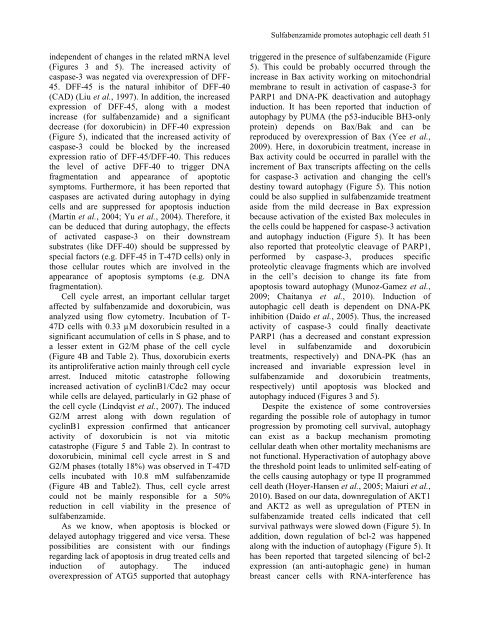10 1 Full Volume (PDF)(jcmb.halic.edu.tr) - Journal of Cell and ...
10 1 Full Volume (PDF)(jcmb.halic.edu.tr) - Journal of Cell and ...
10 1 Full Volume (PDF)(jcmb.halic.edu.tr) - Journal of Cell and ...
You also want an ePaper? Increase the reach of your titles
YUMPU automatically turns print PDFs into web optimized ePapers that Google loves.
independent <strong>of</strong> changes in the related mRNA level<br />
(Figures 3 <strong>and</strong> 5). The increased activity <strong>of</strong><br />
caspase-3 was negated via overexpression <strong>of</strong> DFF-<br />
45. DFF-45 is the natural inhibitor <strong>of</strong> DFF-40<br />
(CAD) (Liu et al., 1997). In addition, the increased<br />
expression <strong>of</strong> DFF-45, along with a modest<br />
increase (for sulfabenzamide) <strong>and</strong> a significant<br />
decrease (for doxorubicin) in DFF-40 expression<br />
(Figure 5), indicated that the increased activity <strong>of</strong><br />
caspase-3 could be blocked by the increased<br />
expression ratio <strong>of</strong> DFF-45/DFF-40. This r<s<strong>tr</strong>ong>edu</s<strong>tr</strong>ong>ces<br />
the level <strong>of</strong> active DFF-40 to <strong>tr</strong>igger DNA<br />
fragmentation <strong>and</strong> appearance <strong>of</strong> apoptotic<br />
symptoms. Furthermore, it has been reported that<br />
caspases are activated during autophagy in dying<br />
cells <strong>and</strong> are suppressed for apoptosis induction<br />
(Martin et al., 2004; Yu et al., 2004). Therefore, it<br />
can be d<s<strong>tr</strong>ong>edu</s<strong>tr</strong>ong>ced that during autophagy, the effects<br />
<strong>of</strong> activated caspase-3 on their downs<strong>tr</strong>eam<br />
subs<strong>tr</strong>ates (like DFF-40) should be suppressed by<br />
special factors (e.g. DFF-45 in T-47D cells) only in<br />
those cellular routes which are involved in the<br />
appearance <strong>of</strong> apoptosis symptoms (e.g. DNA<br />
fragmentation).<br />
<strong>Cell</strong> cycle arrest, an important cellular target<br />
affected by sulfabenzamide <strong>and</strong> doxorubicin, was<br />
analyzed using flow cytome<strong>tr</strong>y. Incubation <strong>of</strong> T-<br />
47D cells with 0.33 µM doxorubicin resulted in a<br />
significant accumulation <strong>of</strong> cells in S phase, <strong>and</strong> to<br />
a lesser extent in G2/M phase <strong>of</strong> the cell cycle<br />
(Figure 4B <strong>and</strong> Table 2). Thus, doxorubicin exerts<br />
its antiproliferative action mainly through cell cycle<br />
arrest. Induced mitotic catas<strong>tr</strong>ophe following<br />
increased activation <strong>of</strong> cyclinB1/Cdc2 may occur<br />
while cells are delayed, particularly in G2 phase <strong>of</strong><br />
the cell cycle (Lindqvist et al., 2007). The induced<br />
G2/M arrest along with down regulation <strong>of</strong><br />
cyclinB1 expression confirmed that anticancer<br />
activity <strong>of</strong> doxorubicin is not via mitotic<br />
catas<strong>tr</strong>ophe (Figure 5 <strong>and</strong> Table 2). In con<strong>tr</strong>ast to<br />
doxorubicin, minimal cell cycle arrest in S <strong>and</strong><br />
G2/M phases (totally 18%) was observed in T-47D<br />
cells incubated with <s<strong>tr</strong>ong>10</s<strong>tr</strong>ong>.8 mM sulfabenzamide<br />
(Figure 4B <strong>and</strong> Table2). Thus, cell cycle arrest<br />
could not be mainly responsible for a 50%<br />
r<s<strong>tr</strong>ong>edu</s<strong>tr</strong>ong>ction in cell viability in the presence <strong>of</strong><br />
sulfabenzamide.<br />
As we know, when apoptosis is blocked or<br />
delayed autophagy <strong>tr</strong>iggered <strong>and</strong> vice versa. These<br />
possibilities are consistent with our findings<br />
regarding lack <strong>of</strong> apoptosis in drug <strong>tr</strong>eated cells <strong>and</strong><br />
induction <strong>of</strong> autophagy. The induced<br />
overexpression <strong>of</strong> ATG5 supported that autophagy<br />
Sulfabenzamide promotes autophagic cell death 51<br />
<strong>tr</strong>iggered in the presence <strong>of</strong> sulfabenzamide (Figure<br />
5). This could be probably occurred through the<br />
increase in Bax activity working on mitochondrial<br />
membrane to result in activation <strong>of</strong> caspase-3 for<br />
PARP1 <strong>and</strong> DNA-PK deactivation <strong>and</strong> autophagy<br />
induction. It has been reported that induction <strong>of</strong><br />
autophagy by PUMA (the p53-inducible BH3-only<br />
protein) depends on Bax/Bak <strong>and</strong> can be<br />
reproduced by overexpression <strong>of</strong> Bax (Yee et al.,<br />
2009). Here, in doxorubicin <strong>tr</strong>eatment, increase in<br />
Bax activity could be occurred in parallel with the<br />
increment <strong>of</strong> Bax <strong>tr</strong>anscripts affecting on the cells<br />
for caspase-3 activation <strong>and</strong> changing the cell's<br />
destiny toward autophagy (Figure 5). This notion<br />
could be also supplied in sulfabenzamide <strong>tr</strong>eatment<br />
aside from the mild decrease in Bax expression<br />
because activation <strong>of</strong> the existed Bax molecules in<br />
the cells could be happened for caspase-3 activation<br />
<strong>and</strong> autophagy induction (Figure 5). It has been<br />
also reported that proteolytic cleavage <strong>of</strong> PARP1,<br />
performed by caspase-3, produces specific<br />
proteolytic cleavage fragments which are involved<br />
in the cell’s decision to change its fate from<br />
apoptosis toward autophagy (Munoz-Gamez et al.,<br />
2009; Chaitanya et al., 20<s<strong>tr</strong>ong>10</s<strong>tr</strong>ong>). Induction <strong>of</strong><br />
autophagic cell death is dependent on DNA-PK<br />
inhibition (Daido et al., 2005). Thus, the increased<br />
activity <strong>of</strong> caspase-3 could finally deactivate<br />
PARP1 (has a decreased <strong>and</strong> constant expression<br />
level in sulfabenzamide <strong>and</strong> doxorubicin<br />
<strong>tr</strong>eatments, respectively) <strong>and</strong> DNA-PK (has an<br />
increased <strong>and</strong> invariable expression level in<br />
sulfabenzamide <strong>and</strong> doxorubicin <strong>tr</strong>eatments,<br />
respectively) until apoptosis was blocked <strong>and</strong><br />
autophagy induced (Figures 3 <strong>and</strong> 5).<br />
Despite the existence <strong>of</strong> some con<strong>tr</strong>oversies<br />
regarding the possible role <strong>of</strong> autophagy in tumor<br />
progression by promoting cell survival, autophagy<br />
can exist as a backup mechanism promoting<br />
cellular death when other mortality mechanisms are<br />
not functional. Hyperactivation <strong>of</strong> autophagy above<br />
the threshold point leads to unlimited self-eating <strong>of</strong><br />
the cells causing autophagy or type II programmed<br />
cell death (Hoyer-Hansen et al., 2005; Maiuri et al.,<br />
20<s<strong>tr</strong>ong>10</s<strong>tr</strong>ong>). Based on our data, downregulation <strong>of</strong> AKT1<br />
<strong>and</strong> AKT2 as well as upregulation <strong>of</strong> PTEN in<br />
sulfabenzamide <strong>tr</strong>eated cells indicated that cell<br />
survival pathways were slowed down (Figure 5). In<br />
addition, down regulation <strong>of</strong> bcl-2 was happened<br />
along with the induction <strong>of</strong> autophagy (Figure 5). It<br />
has been reported that targeted silencing <strong>of</strong> bcl-2<br />
expression (an anti-autophagic gene) in human<br />
breast cancer cells with RNA-interference has
















